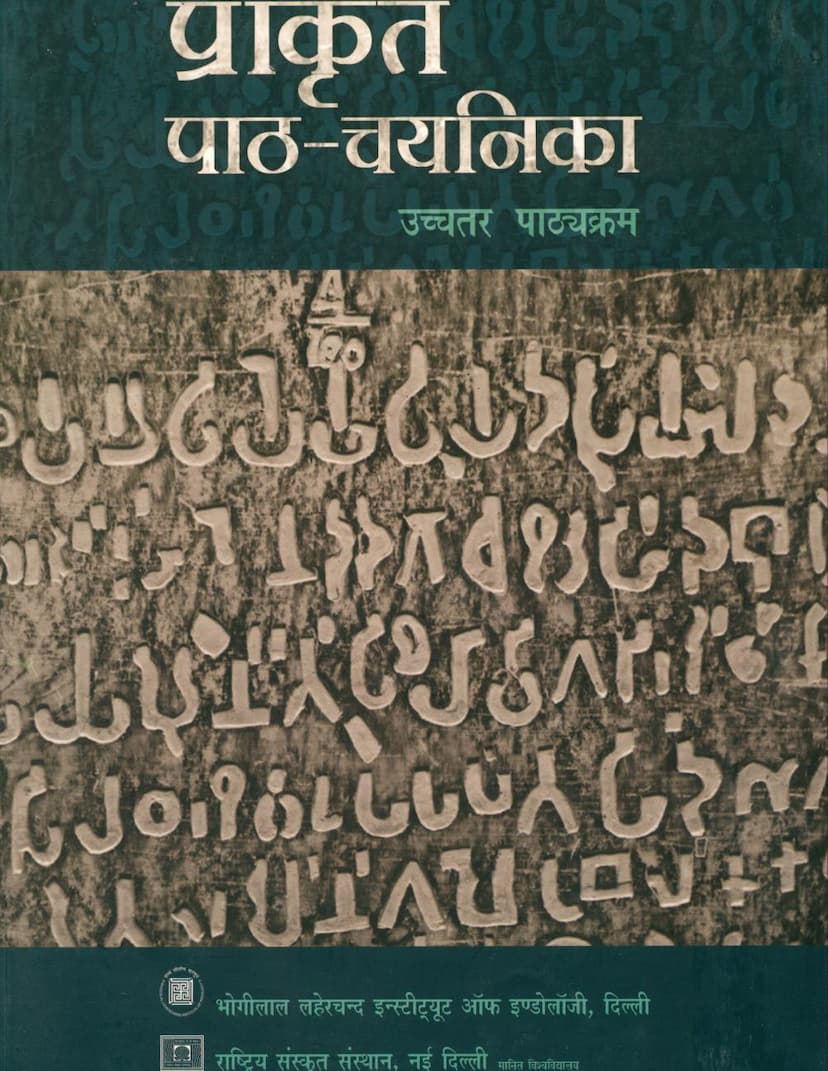Prakrit Path Chayanika Ucchatar Pathyakram
Added to library: September 2, 2025

Summary
This document is the Prakrit Path Chayanika for the Advanced Course, published by the B. L. Institute of Indology, Delhi, in collaboration with the Rashtriya Sanskrit Sansthan, New Delhi. The cover design features an Ashokan inscription in Prakrit from the 3rd century BC, housed in the Bhubaneshwar Museum.
The Introduction emphasizes the significance of Prakrit as a major vernacular language in ancient India for centuries, influencing the literature, history, culture, and daily life of the populace. It is considered the mother of many Indian languages. Even the earliest Vedic language shows Prakrit elements, suggesting a widespread spoken Prakrit dialect during that time. Great religious figures like Lord Mahavir and Lord Buddha are credited with initiating a linguistic revolution by using this vernacular for their teachings. Prakrit literature flourished from the 6th century BC to the present day, encompassing various genres like philosophy, religion, logic, social sciences, history, art, culture, mathematics, astronomy, architecture, sculpture, and values.
The introduction expresses a lament that Prakrit, despite its historical importance, is now neglected and struggles for recognition. The B. L. Institute of Indology has been working for 24 years to promote Prakrit language and literature through various activities. These include organizing national and international seminars, lectures, and awards, preserving a vast collection of over 25,000 ancient manuscripts, establishing an archaeological museum, and publishing rare and important texts.
The institute is highlighted as a unique research institution that actively promotes the study of Prakrit language and literature. For the past 24 years, it has been conducting intensive 21-day summer workshops for Prakrit language and literature. These workshops are offered free of cost with full facilities to professors, research scholars, and other interested individuals from higher education institutions across India.
The Advanced Course presented in this book is a result of the scholars' long experience and evolving needs, designed to provide a comprehensive study of Prakrit. Its primary focus is on grammar, enabling students to grasp the meaning of texts while also understanding the nuances of different Prakrit dialects and their grammatical structures. This approach aims to facilitate the understanding of any Prakrit literary work.
The introduction proudly mentions that scholars trained at the B. L. Institute of Indology are able to explain the Prakrit dialogues in Sanskrit dramas based on the original Prakrit language, rather than solely on their Sanskrit translations. The institute takes pride in the proficiency that participants achieve in just 21 days, which is often described as unattainable elsewhere even in 2-3 years.
The publication of this course material has been long-awaited and is now made possible with the support of the National Sanskrit Sansthan. The introduction expresses gratitude to Professor Radhavallabh Tripathi, the Honorable Vice-Chancellor, and acknowledges the invaluable contributions of experienced scholars in Prakrit, Sanskrit, and Apabhramsha languages and literature. Special thanks are extended to Professor Gaya Charan Tripathi for his guidance and to Dr. Jitendra B. Shah, the esteemed Vice-President of the Institute, and all other trustees. The institute also looks forward to suggestions for further enhancing the course.
The Syllabus lists the texts included in the advanced course, categorized into Poetry, Prose, and Drama.
Poetry:
- Prakrita Dhammapada (Brahmana Varga)
- Uttaradhyayana-sutra (Namipavajja)
- Dasavaikalika-sutra (Ayarapanihi)
- Gatha Saptasati (Selected verses)
- Setubandha (Description of the Rainy Season)
- Gaudavaho (by Vakpatiraja - Commencement of the Poem)
- Panchastikaya (by Kundakunda)
- Bhagavati-Aradhana (Main Gatha Collection)
- Kumarapalacarita (First Canto)
Prose: 10. Ashokan Inscriptions (Girnar Rock) 11. Kalsi Inscriptions 12. Dhauli Inscriptions 13. Hathigumpha Cave Inscription of Kharavela 14. Inscriptions from Central Asia 15. Upasakadasa-sutra (Pathama Anandajjhayanam) 16. Kuvalayamala-kaha 17. Jacobi's Selected Narratives (Muladeva Katha - Mandiyachoro) 18. Sakhandagama (by Acharya Pushpadanta-Bhutabali)
Drama: 19. Mrcchakatika (Collection of verses) 20. Mrcchakatika (Vasantasena's dialogue with the Shakar) 21. Karpura-manjari (First Act - First Interval) 22. Spurious Gatha Collection (Sputa Gatha Sangraha) 23. Ratnavali (Maharastri Prakrit) 24. Yashovarma-charitam
The subsequent pages provide the actual Prakrit text of several of these works, starting with excerpts from the Prakrita Dhammapada, Uttaradhyayana-sutra, Dasavaikalika-sutra, Gatha Saptasati, Setubandha, Gaudavaho, Panchastikaya, Bhagavati-Aradhana, and Kumarapalacarita. Following these are the texts of the Ashokan Edicts (Girnar, Kalsi, Dhauli, Hathigumpha), inscriptions from Central Asia, and sections from Upasakadasa-sutra, Kuvalayamala-kaha, Muladeva Katha, and Sakhandagama. The later part of the document seems to contain excerpts from dramas like Mrcchakatika and Karpura-manjari, and other poetic works. The extensive inclusion of these texts suggests the book serves as a primary reader for students of advanced Prakrit.